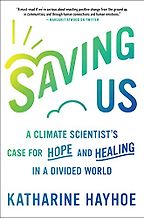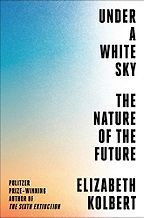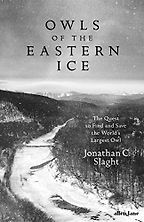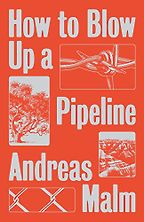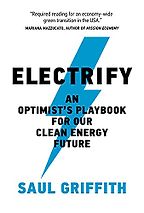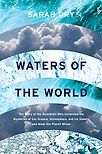Where are we at with climate books in 2021? When we spoke a couple of years ago, quite a few of the books you chose—not all of them—were quite descriptive. Whereas now, it’s much more about how we’re going to solve this. Has the emphasis changed?
I agree. I think there is a much more pragmatic and practical tone to several of the books that I’ve selected. Without wanting to play into these narratives of ‘we only have x amount of time left’, there is a sense that now is the time to act.
Perhaps some of that, in the UK at least, is related to COP26 coming up. Perhaps some of it is around the sense that certain cultural, economic or political tipping points have been reached that make it feel that action is more possible. Some of it may have to do with my own tastes shifting, and being more interested in reading books that essentially say, ‘Yes, we can—and here’s how’.
Let’s look at the books you’ve chosen. First up is Saving Us by Katharine Hayhoe, subtitled A Climate Scientist’s Case for Hope and Healing in a Divided World. So this book is very much about how her experiences as a scientist, trying to find common ground to discuss climate change with people. Tell me about the book.
I really like Katharine Hayhoe as a communicator. She is a climate scientist as well as an evangelical Christian and a Canadian who lives in Texas, so she covers a lot of ground. This book was written on the back of a TED talk she gave that almost four million people have viewed. She is someone who uses all of the channels and mechanisms that she can to get the word out, which I heartily approve of.
It’s not a literary book. I would say it’s a how-to manual, in a sense. It could be subtitled ‘how to talk to people about climate change’. One of the things she says that has stayed with me the most is also the simplest, which is that the most important thing any of us can do about climate change is talk about it. In this book, she shows why that’s important and how to go about it.
To explain why it’s important, she refers to a classification system put together by two researchers, Tony Leiserowitz and Ed Maibach, on what they call “Global Warming’s Six Americas“. Instead of thinking about climate ‘deniers’ and climate ‘believers’, they have done research that divides members of the American public into six groups when it comes to climate change, ranging from alarmed, to concerned, to cautious, to disengaged, to doubtful, to dismissive. That’s a lot of groups. The percentages of people that fall into the groups has been changing, but essentially the people who are alarmed and concerned are growing and people at the other end are dropping. What Katharine Hayhoe says is, ‘Sometimes you have to know when you can’t engage. You’re never going to convince the dismissives, but they’re only 7% of the population, so forget about them. The good news is that 93% of people can be engaged with in some way.’ That’s her starting point, that it’s not about polarization. It’s not about us, or them. It’s about this spectrum. And if we think about moving people along the spectrum, any bit that we can move them along is a good thing. She’s very practical. It’s not about absolutes. It’s about meeting people where they are.
I really liked her idea of appealing to people with shared interests. For example, if you’re part of a group of snowboarders, you can talk to them about the fact that if we’re not careful we’re not going to have much snow to snowboard on.
Right. And if you’re meeting with members of the Texas Water Development Board, who are politically very conservative, talk about water data, because that’s going to speak to them. Or if your grandmother is a knitter, you can knit a scarf with her that has the warming stripes on it and talk about the warming stripes. It’s really founded on a deep and yet very practical empathy. Ask yourself, ‘What does this person care about?’ and connect with them on that.
“The most important thing you can do is talk about climate change”
For Hayhoe, I think that’s based on a Christian faith, that to be a good Christian is to evince love and caring for others, and notably others who are poorer and less well off than we are. But of course those values aren’t only held by Christians. So we need to think not just about people in our local communities, but also about the impact that climate change will have globally. But she’s very resolute about keeping it close to home. Part of the reason that people have been paralyzed in terms of how to act on climate change, she suggests, is because it seems abstract and distant. She’s really a genius, I think, at finding points of common values—which are always going to vary, they won’t all be the same—and continuing to find the energy to find those points of contact. That, to me, really is very inspiring.
Also, we’re talking about climate books of 2021, but her approach is quite inspiring for any topic on which there is polarization because, as she points out, across a range of issues, people have determined their opinion based on what their political tribe thinks, rather than on the facts or the evidence.
This comes back to the problem with issues that are seen as scientific. Certain people want them to be disposed of by facts. What Hayhoe shows in this book, over and over again, is that facts aren’t enough. They’re not irrelevant. She’s very clear that when it comes to the kinds of conversations you might have with people on this spectrum, you might start with a very brief and factual rebuttal of certain myths and arguments that might be put forward against climate change. But she says not to spend too long on that, and not to get distracted by it. Very quickly, what you need to do next—which is much, much more important—is show what people can do. Give them practical responses that they can take so that they’re not confronted with so-called facts that leave them feeling impotent or angry.
The facts are preliminary and necessary, but completely insufficient not just to motivating action, but generating this shared set of values that are necessary to achieve common political will on so many issues.
I thought it was funny when she wrote about a man who was going to various churches to talk to the congregation about climate change. When she asked him what his belief was, he said he was an atheist. And she was like, ‘No, no, no, you’re completely the wrong person to talk in church about climate change!’
Sometimes you have to know when you’re not the one to make the connection. You have to meet people not just where they are, but where you are. So find out what matters to you: if you love having dinner parties, have people over to dinner and talk to them about where the food has come from, or if you love gardening, connect with other gardeners…In a way, there’s really no excuse for not doing it.
It’s a very optimistic vision of engagement, I suppose, but I think we need the example of that kind of optimism because it’s so easy to be paralyzed by a sense of overwhelming pessimism. Katharine Hayhoe is not naive about the challenges we face, both in terms of the physics of climate change and the politics of climate change, the tribalism that confronts us when we try and act. But she has been able to show not just the positive outcomes of this kind of approach, but the scale of the outcomes that you can achieve. She gives the example of someone in Wandsworth, in London, who heard her say that the most important thing you can do is talk about climate change. He sent her an email saying that he had taken that to heart and had recorded the number of conversations he’d had, and the conversations that those conversations had begotten, and it was more than ten thousand.
A big part of the impact of this is that we need to keep sharing, we need to keep motivating each other with these good news stories. In a way, what she’s showing is that addressing climate change is partly a communications issue. I have a lot of sympathy with that view. It happens that she’s an excellent climate scientist as well as an excellent communicator and that gives her a kind of authority. But I think if we take seriously what she’s saying, hopefully we’ll need the authority of climate scientists less and less going into the future, and we can all be advocates for our own portion of the planet, as it were. It’s not just the climate scientists who speak on behalf of the planet, it’s potentially each of us.
Let’s go on to Under a White Sky by Elizabeth Kolbert, who is a very well-known writer in the environmental space and won a Pulitzer Prize for her book, The Sixth Extinction (2014). I guess this is probably a gloomier book? Tell me about it and why you’ve chosen it.
Elizabeth Kolbert is good at the telling detail. In this book she’s looking at case studies of what she calls ‘the control of the control of nature’. It’s this weird recursion that she says is a characteristic of the Anthropocene, where our attempts to control nature have given rise to second order problems and unintended consequences. However, it’s too late to do nothing. Now, in order to save elements of nature, we must try to control the effects of previous attempts to control them.
The book starts with a case study of the Chicago River, which was reversed in the early part of the 20th century as part of a massive hydro engineering project with repercussions for a large portion of the hydrology of the United States. This had significant ecological consequences that were not foreseen, leading to the introduction of a species of Asian carp to try and deal with aquatic weeds, which in turn led to more unintended consequences. Ironically, the Asian carp were introduced in 1963, which was the year after the publication of Rachel Carson’s Silent Spring, in which she made the case against chemical pesticides and biocides and in favor of biological controls, of which the Asian carp was a prime example. So here was an example where a seemingly natural solution was implemented, which had just as many unintended consequences as these chemical solutions. What I think Kolbert wants us to consider is that the linkages between ecological and human systems are so complex that it’s very hard to know what the effects of our interventions will be.
Get the weekly Five Books newsletter
She uses a lot of examples to show how extremely well-meaning and concerned scientists end up trying to understand, tinker with and manage natural systems using ever more technology and interventions, to save something that we might still think of as natural. One of the most poignant examples she uses is this species of fish that are found in tiny pools in Death Valley National Park. Some of these pools are the size of a swimming pool and they contain these tiny little fish called pupfish. And because these pupfish have been isolated, one pool may contain the only population of a certain species of this fish. As a result of climate change, some of these pools are drying up. There’s this example where a biologist is carrying the total population of one of these pupfish in two buckets, trying to transport it to another pool. Then they create artificial pools, and these scientists are trying to breed the pupfish. But the pupfish only release a single egg at a time, so they’re trying to track these microscopic eggs and coax tiny populations of tiny pupfish to reproduce.
Kolbert is the kind of writer who wants to present us with an image and encourage us to consider the meaning of that image for ourselves. She doesn’t tell us precisely how to make sense of this, but she presents it with a wry, slightly detached air. It has a somewhat bloodless feeling to it, and a valid criticism of the book that can be made is that she doesn’t engage with the economic and political causes of a lot of these interventions, and the way that they impact different people in different landscapes differently. But, at the same time, she has a very good eye for the telling case study and the telling detail, revealing the tragic absurdity of the circumstances that we find ourselves in, which is only going to increase.
Isn’t the book a bit paralysis-inducing, then? If by intervening to try and stop climate change, we’re only going to make things worse, won’t that contribute to a sense of despair?
I didn’t feel that when I was reading it. I think that’s because the people who are involved in doing this are so thoughtful and dedicated and passionate and self-aware of the issues, of this paradox of trying to restore nature through technological interventions, that it provokes a sense of respect, both for the professional expertise and care of the people involved and for the complexity of nature.
And, I guess, to say that nature is complex and that our interventions have unintended consequences is only the first step. For me, it doesn’t necessarily need to be seen as inducing paralysis if it makes us humbler and more thoughtful. It doesn’t mean not acting, it means acting on the basis of the best information, the most thoughtful deliberation, the best communication about the potential consequences that we can. And remember that doing nothing is also a kind of intervention.
What did the carp in the Chicago River do, by the way?
They basically take over and eat almost all the native species of fish. They’re also dangerous to human beings because they jump out of the water, and people riding in motorboats collide with them at speed and can be seriously injured. Part of the intervention in that case was trying to get people to eat the carp, on the assumption that the only more voracious eater than an Asian carp is a human being. The problem is that the carp are notoriously hard to prepare, they turn into kind of mush when you try and debone them. Lots of money is now being invested in trying to create tasty Asian carp patties.
There’s lots of examples of this happening, like the cane toads in Australia that were introduced in the 1930s to control beetles that were damaging crops and then basically ate everything. They’re also poisonous, so a lot of endemic species ate the cane toads and were poisoned by them.
Okay, now we’re at the book about the owls who live in the Russian Far East. Tell me about Owls of the Eastern Ice by Jonathan Slaght.
In a way, this isn’t an obvious book for best of climate books of 2021 because it’s about a field biologist doing fieldwork in eastern Russia along the Samarga River. What appealed to me about it was how the author—who spent four years tracking these very elusive owls that live along semi-frozen rivers and feed uniquely on fish—was so dogged, obsessive and single-minded in his pursuit of these creatures, in a very extreme and unforgiving habitat, with occasionally very odd and slightly threatening human beings lurking at the edges. It’s a classic quest story in many ways, and compulsively readable. It’s told in a very unembellished way. He’s a good writer, but he’s not trying to convince the reader of anything. He’s simply inviting us to share in his unique obsession with these animals, called Blakiston’s fish owls, which are the largest living owl of their kind. They’re up to two-and-a-half feet tall and their wingspan is more than six feet. So they’re absolutely massive, and they live in these enormous old growth trees along the river.
“The facts are preliminary and necessary, but completely insufficient”
It’s another version of what we can do. If Under a White Sky is presenting an impossible paradox of how we thread this Anthropocene needle of controlling our attempts at control, this is an impossible quest story. First to find the owls, and then to find ways to save them. Along the way he and his assistants design new ways to trap the owls because no one had ever tried to trap them before. They end up designing this special box that actually sits in the river, and which they stock with fish. They come up with this elaborate system of nets to capture these birds. He ends up becoming quite proficient at trapping them and then has to learn how to tag them using these special battery-powered GPS devices. He then has to recover the devices to get the data, so they have to trap the owls again. It’s a quest against impossible odds, and yet he is successful in achieving his goal, which is to understand the population of these animals, what controls that population and what kind of habitat they need to survive, so that he can help advise on creating a conservation plan.
The book is a strange mixture of pessimism and hope. On the one hand, you see that the logging companies—which lease a lot of the prime habitat that these owls live on—are using many of the old growth trees that these owls need to roost in to create bridges across the river. It’s a kind of a lazy man’s bridge: they just knock the trees over. On the other hand, once Slaght realizes the importance of these relatively uncommon old growth trees with big enough holes in which the owls can nest and tells the logging companies about it, they seem to be quite happy to cooperate and make slight adjustments which potentially have a huge impact on preserving these owls’ nesting habitat. There’s a lesson here, which is that one person really can make a difference to our understanding, and that that understanding can enable relatively straightforward interventions that have a disproportionate effect. That’s what I really enjoyed.
Now in our list of 2021 climate books we’re at How to Blow up a Pipeline by Andreas Malm. That’s quite a strong title: is he really advocating blowing up a pipeline?
No, I think the book could more accurately be titled, ‘why blowing up a pipeline should potentially be part of the climate activist’s toolkit’. Or perhaps it should be called, ‘how to puncture a tire’. Malm is now a very productive academic in Sweden, who’s written several books on the history of what he calls ‘fossil capitalism’, linking climate change and capitalism. He calls himself an eco-Marxist, so he’s quite open about his political perspective.
But he started out his young adult life in climate activism and one of the things that he did as a climate activist was to go around letting the air out of SUV tires. He uses that as an example of the strategic use of violence that he’s advocating. It’s a short book, and it’s a polemical book. It has a lot of rhetorical gambits that don’t necessarily play out. But I chose it because I appreciated Malm’s provocation. The title may be too provocative and not doing his argument any favors, but I feel comfortable recommending it—even though I wouldn’t advocate for a book that was literally telling people how to blow up pipeline—because I think Malm raises some important points.
What are those?
The key point he’s making is that climate protests have only been increasing over the last 25 years, but they haven’t come close to achieving the kinds of actions that are needed to address climate change. He divides these cycles of protest and activism into three phases. It starts in 2006 in Northern Europe—it’s a very Eurocentric book—in the runup to COP15. Then he talks about 2011 and the protests focusing on the Keystone XL pipeline in America. Then, in the summer of 2018, Greta Thunberg and Extinction Rebellion emerge. Malm identifies this climate movement as becoming the single most dynamic social movement. But, across the same period of time, he notes that emissions have only continued to increase. So at the first COP, which was in April 1995, carbon dioxide concentration was 363 parts per million. Right now it’s about 412 parts per million. So what have these protests achieved, if emissions seem to only be increasing? Does there need to be another phase beyond peaceful protest?
“One person really can make a difference”
Then he spends a lot of time shooting down a lot of the arguments that are made by groups like Extinction Rebellion, advocating for nonviolence and pointing to the success of nonviolent protests in the past. These are examples like the abolitionists, the suffragettes, Gandhi, those fighting apartheid. Malm goes through systematically to show that, actually, the threat of violence was central to the success of all of those movements. Now, I don’t have expertise in all these movements, and I don’t know that Malm makes a watertight case. But I think the point that he’s raising is important, which is that given the urgency of the situation and given what’s at stake, we should at least be talking about why we might want to consider the form of violence known as property destruction as part of a range of climate activism. In a funny way, this is similar to when Katharine Hayhoe says, ‘it’s not all or nothing, it’s not you’re against us or you’re with us, it’s about a spectrum of opinion.’ I think Malm is saying that our climate activism has to encompass a range of approaches. And one end of that range should be at least the possibility of targeted violence, he suggests. He says that sabotage can be done ‘softly, even gingerly’.
So just letting the air out of SUV tires?
Or even slashing them. Taking an action where it’s extremely unlikely that someone might get hurt and where the violence is focused specifically on property that is part of the fossil fuel infrastructure. So SUVs, but also things like oil refineries and pipelines.
Now, it’s not straightforward because a) it’s impossible to ensure that people don’t get hurt, b) that kind of action risks backfiring and could cause public attitudes to turn against activism, and c) the people involved are being asked to risk serious jail sentences, and is it morally justifiable to expect individuals to do that? So there are a lot of good arguments against it. But I think Malm is doing a service by suggesting it’s something we should at least be talking about. I think he wants to suggest that it should be imaginable that we might start to damage property as part of climate activism. He says that right now it is easier to imagine the end of the world than the end of capitalism and he wants to change that.
Wow, so quite a radical book you’ve chosen there.
Yes, and I don’t know that I came out of it agreeing with Malm. But I did come out of it thinking about things differently than I had been. He forces us to consider why certain things feel more unthinkable than others. In doing that, he is moving the conversation along.
The book doesn’t really engage very substantively with either the history or the contemporary set of issues at play in the Global South. It’s very much focused on Northern Europe, which is fine, but I’m not sure that he is as open about that as he might be.
I’m not sure I agree with him on the historical examples of nonviolence actually being violent, certainly in the case of Gandhi, but I’m interested in this idea of having an effective toolkit to put pressure on people. I grew up near Rome in Italy, where although it’s much warmer than the UK, you often see women wearing fur coats. In the UK you rarely do, because traditionally activists threw red paint at anyone who was wearing one in public. That really reduced their attractiveness, because even if you disagreed with the activists, who wants to walk around town worrying about getting covered in paint? These forms of pressure can be very persuasive.
In a way what was most affecting about the book is when he talks about how he felt having taken these actions. So, in addition to letting the air out of the tires, he helped knock down a fence surrounding a power plant. He writes, “for one throbbing mind-expanding moment, we had a slice of the infrastructure wrecking the planet in our hands”. Now, that’s a sense of agency that can feel so lacking in other settings, and in the kind of image of the world that someone like Elizabeth Kolbert presents to us. If we’re thinking about how we motivate each other, and ourselves, to act, it’s worth thinking about where we can get a feeling of agency. Now I’m not advocating that agency should come at the expense of safety or even potentially property, but it would be naive not to take it into account as an important factor. I guess the question is, can we transmute that into the kind of political engagement that might result in changing regulations, and which ultimately needs to happen for large-scale system change to take place?
Okay, we’re at the last of your 2021 climate books, Electrify by Saul Griffith. This is a very empowering book.
The subtitle of this book is ‘an optimist’s playbook for our clean energy future’. That’s very accurate: it’s optimistic, and it’s a playbook. It reads a bit like a PowerPoint presentation and I mean that in a good way. It’s very clear, it’s very practical, it’s very possiblist. It’s very much focused on the technical rather than the political without being naive about the need for political will.
What are the technical possibilities for addressing climate change? Saul Griffith’s answer is that we already have the most important technical solution in front of us and it’s electrification. Basically, it’s very simple: we have to electrify everything and we have to do it as quickly as possible. He uses the language of the moonshot, that we need an equivalent scale of response to that which the United States mounted during the space race, or, to take another example, during World War Two, or when it was funding the Manhattan Project. It sounds like a lot of investment, but it’s not impossible. It’s possible, it just requires a concerted effort. He’s also very careful to link this to jobs creation. So there are a lot of a win-wins—and even some win-win-wins—in this book.
Five Books interviews are expensive to produce. If you're enjoying this interview, please support us by donating a small amount.
The biggest win is that electricity is a much more efficient source of energy than fossil fuels. A lot of heat is wasted burning coal and gas and oil to turn turbines, so energy is wasted along the way. When we use solar and wind power to generate electricity, there’s a much better conversion of energy into a usable form. The central chapter of the book, which is called “Electrify!”, sets out how we can save 42%—almost half—of the energy we use today by electrifying things. This is partly as a result of the increased efficiency of renewable-generated electricity, but it’s also because electric cars are more efficient than cars with engines. I was also really amazed to see how much energy it costs to actually mine and refine fossil fuels. Apparently 11% of the energy that we use is dedicated to getting fossil fuels out of the ground, so we save a lot just by not trying to mine them. Then we should be doing things like electrifying heating in buildings and using LED lights.
The emphasis throughout is on large-scale infrastructure changes as well as large-scale personal changes. He says you shouldn’t be sweating the small stuff. Things like the kind of car you drive, installing solar panels on your house, installing a heat pump, those are one-time decisions that are hugely more consequential than the small decisions we make every day about where we set our thermostat. Another message that he gives is not to worry about efficiency. That’s again a win-win. In the 70s, the response to the energy crisis was to try and make people use less energy and be more efficient. He says we don’t need to do that. If we electrify things, we can have it all: we can have new jobs, clean energy, and copious amounts of it.
He’s definitely an optimist, isn’t he? What’s his background?
He’s an engineer who’s also studied information technology. That was one of the things that interested me, that in addition to installing many, many more wind turbines and solar panels on both domestic architecture and on very large scales, we need a new kind of energy grid, that operates a bit like the internet. There’s something called grid neutrality, so that everyone can contribute to and draw from the grid in ways that are equivalent. I think that’s a big part of making it more efficient, both from an energy perspective, but also economically. He brings this perspective on networked systems that he gained as an information technology person to the question of the electrical grid, which is quite unique.
He’s Australian-American, but it’s very much focused on the United States. He writes that it’s been through a rough patch with COVID, but that America is always good in a crisis and will rise to the occasion.
Yes, it’s “pull up your socks, you’ve done it before.” It is very US-centered, and he’s got lots of examples of how this has worked in the past. He talks about the establishment of the National Parks and Monuments under Roosevelt, the New Deal, the Rural Electrification Act of 1936, the Civil Rights acts, the founding of the Department of Energy and the Environmental Protection Agency, smoking cessation. We’ve had big challenges in the past, and we’ve risen to meet them.
And by ‘we’ he really is saying that we need government level, regulatory support, as well as financial tools. He says that to convert US homes to have the solar panels and heat pumps they’re going to need will cost about $70,000 per home. So, we need financial tools for these kinds of climate interventions equivalent to the mortgages we have for property that will enable households to afford this. To his credit, he’s really good at linking up his technological optimism—that could be almost Silicon Valley boosterism—with his advocacy for massive government support and intervention. He isn’t saying that the marketplace is going to take care of things, even with certain subsidies. He’s saying that we need a generational level of regulatory innovation from the government. In that sense, it’s quite refreshing.
I got a bit of a shock reading that I needed solar panels and a heat pump for my house as well as an electric car. I was thinking, at first, that I needed to make these changes right away. But he’s not saying that, he’s saying, ‘when your current car/boiler dies, your next one has to be electric/heat pump’. You don’t have to rush out immediately.
Exactly. He’s taking into account the lifetime of the fossil fuel-using objects that we have now. But he’s also quite clear about saying that it has to stop right now. No one can be buying more petrol or diesel cars, and we certainly can’t be building more oil refineries or coal mines. We need to have a scale of solar and wind power that will transform the landscape. He estimates that we’re going to need 15 million acres of solar panels. That’s out of 2.4 billion acres of land in the US, so it’s a tiny percentage, but it’s still a huge area. We’re going to have to learn to live with a very changed landscape, with wind turbines and solar panels all over the place. He says we need to triple current electricity production in the US. These are possible targets and he sets out exactly how we might get there.
Then Elizabeth Kolbert can write a book about the unintended consequences of these millions of acres of solar panels.
It’s true. There’s an interesting non-dialogue between these two books. Frankly, I’d rather be in Saul Griffith’s camp because he’s very well informed, and very data driven. He uses a lot of charts to try and bring the reader along with him and says, ‘You can understand this. Once you do, and start tracking things, you can start to see what the low-hanging fruit is in the climate crisis.’ And what he calls clean energy infrastructure—which is essentially electrification—is a real low-hanging fruit. Just as we can go a long way (not all the way) towards saving the fish owls by identifying what they need for their habitat, we can get a long way towards where we need to be by scaling up technologies that we already have. There’s a lot of power in that knowledge if we implement it.
He mentions how he drives his wife crazy, because he’s always measuring how much energy every activity takes. With climate change, I’m always wondering what to focus on, and having that data is really helpful.
Well, the US military uses an ungodly amount of fuel in its jets—at 0.5% it’s a shocking percentage of overall US energy use, especially when you compare it to the 0.7% used transporting children to school or church. That really puts things in perspective. As voters, we do need to be informed so that we can vote in politicians who are likely to pass the kinds of regulations that we need. Over and over the message from people who are working on the front end of climate change—and know better than anyone else the scale of the challenges we face—is how important it is to have hope. Not unfounded hope, but optimism based on smart people working really hard to generate useful data and useful ideas. That’s not to say that there aren’t risks of overreaching the bounds, of overstepping, of unintended consequences. But the risks that we face now from climate change are so great that it’s far past the point of the so-called precautionary principle which has been used in the past to justify inaction.
Five Books aims to keep its book recommendations and interviews up to date. If you are the interviewee and would like to update your choice of books (or even just what you say about them) please email us at [email protected]
